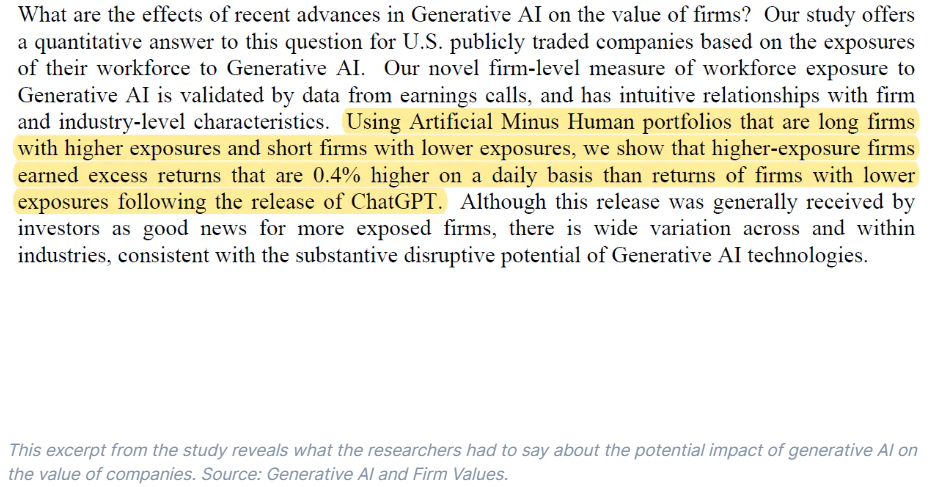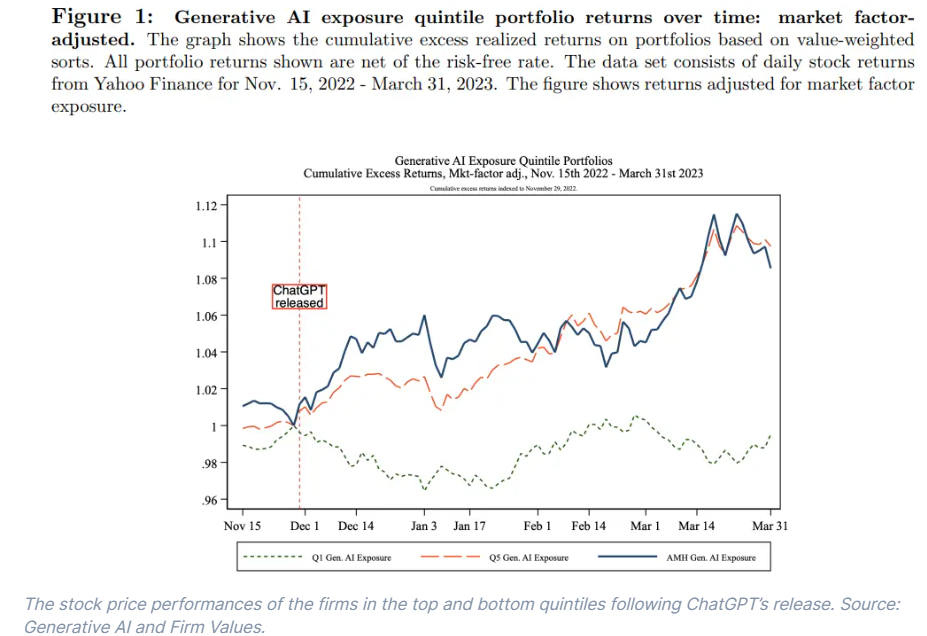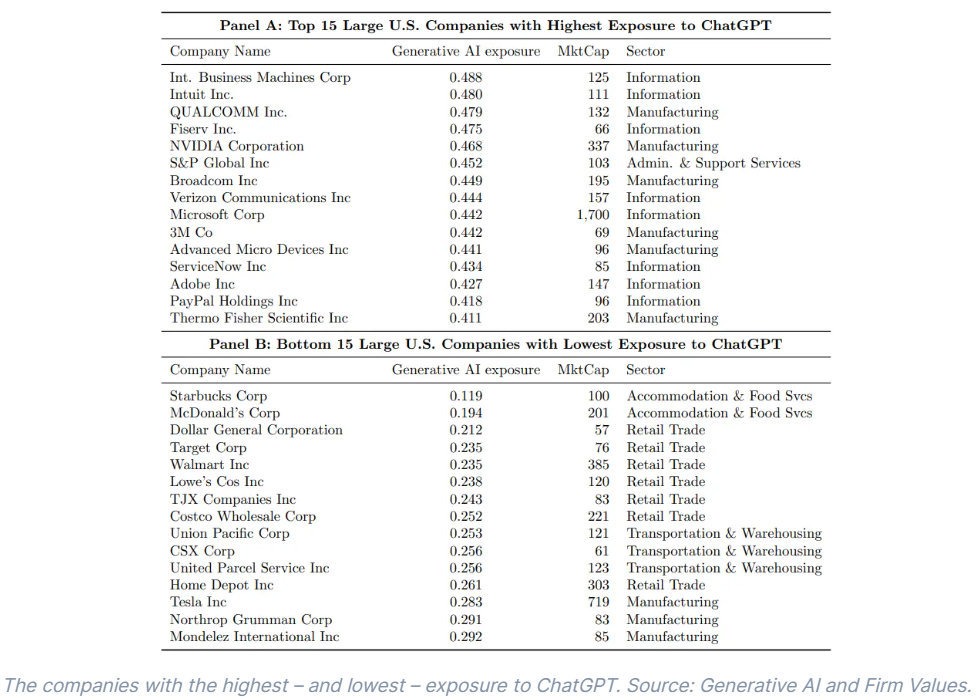The stocks set to benefit most (and least) from AI, ranked
19th May 2023 10:17
by Reda Farran from Finimize
Researchers have identified the companies set to benefit the most and least from ChatGPT, offering savvy investors a good starting point to capitalize on the AI trend.

Generative AI technologies can boost a firm’s free cash flow (FCF) by lowering its labor costs and/or making its workforce more efficient. More FCF, in turn, should increase the firm’s market value.
A key study found that following ChatGPT’s release, firms whose workforces can benefit the most from its use saw their stock prices perform significantly better than those of firms that stand to benefit the least.
You can use the researchers’ list of the 15 firms with the highest exposures to ChatGPT as a starting point for stock ideas to dig into. Companies in the top 15 that can also use generative AI to drive revenue growth might be among the most attractive.
Sometimes the future seems to almost rush at you. Recent advances in generative AI – those machine learning models like OpenAI’s ChatGPT that are capable of creating new and unique content – have certainly felt like that. And the major technological breakthrough will have important implications for corporate profitability and, in turn, stock prices.
That prompted three researchers from the National Bureau of Economic Research to conduct a key study to quantify the impact of AI on firms’ market values. And the best part of their novel work is this: they’ve identified the companies set to benefit the most and least from ChatGPT, offering savvy investors a good starting point to create long-short portfolios to capitalize on the AI trend.
What was their thesis?
The researchers believe that generative AI tools could lead to an increase in some companies’ market values. That’s because these technologies can boost a firm’s free cash flow (FCF) by affecting its workforce in two major ways.
First, some of a company's workers might be replaced with less expensive AI technologies, which would boost FCF by lowering operating costs. Second, companies may find their employees becoming more efficient by using AI to get things done better and faster. That improved efficiency can lead to higher profits and, in turn, more FCF.
How’d they look into it?
The researchers assigned each publicly listed company in the US with a score based on how exposed the firm’s workforce is to generative AI. The higher the score, the greater the company’s share of employees doing roles that could be enhanced (or replaced) by the technology. The minute details of how they did this can be found in the research paper itself, but here’s a simple breakdown:
First, the researchers looked at nearly 20,000 different work tasks done by humans, and used ChatGPT to figure out whether these tasks could be done by the AI now – or in the future with some improvements. They then grouped these tasks by occupations using a database called O*NET.
Next, they linked these occupations to specific companies that are publicly traded, using data from Revelio Labs. This data comes from millions of publicly available profiles of employees, like those found on LinkedIn. This way, they could see how much each company could potentially benefit from using ChatGPT, based on the tasks their employees do.
Then, they checked whether their scores were accurate by looking at companies’ recent earnings call transcripts. They found that companies that talked more about generative AI in these calls were also the ones that scored most highly, validating the researchers’ methodology.
Finally, they sorted all the companies into quintiles based on their scores, and compared the stock price performances of the firms in the top and bottom quintiles following ChatGPT’s release.
And what’d they find?
In short, they found that when ChatGPT arrived on the scene, it had a sizable positive impact on the value of firms whose labor forces are more exposed to generative AI. Here’s the key conclusion in the researchers’ own words:

Put differently, firms whose workforces can benefit the most from the use of ChatGPT saw their stock prices perform significantly better than those of firms that stand to benefit the least. This outperformance amounted to 0.4% in daily excess returns during the two weeks following ChatGPT’s release. That’s huge when you consider that a daily 0.4% excess return translates into more than 100% on an annualized basis.

Two more things stood out for me from the results. First, the outperformance wasn't just because some industries can use AI better than others. Even within the same industry, stocks of companies that can use ChatGPT more effectively performed better by about 0.4% in daily excess returns compared to stocks of firms that can’t use it as effectively. Second, the outperformance wasn’t a temporary bump that later normalized. From the graph above, you can see that the AMH (artificial minus human) portfolio, which is long the highest-exposure quintile and short the lowest-exposure quintile, achieved a cumulative return of over 9% from ChatGPT's release date until March 31st, 2023.
Which companies stand to benefit the most (and least) from generative AI?
This table shows the 15 firms with the highest and lowest workforce exposures to ChatGPT among the 100 biggest US firms by market capitalization.

Not surprisingly, many IT firms have a huge swath of employees whose jobs are exposed to ChatGPT. The researchers also found that industries with higher exposure tend to pay bigger wages, suggesting that more workers in well-paid positions could see their careers transformed by the technology. Industries with higher exposure also tend to have more employees compared to their capital, spend more on research and development, and have fewer physical assets. On the flip side, firms with lots of employees doing manual, physical tasks stand to benefit the least from ChatGPT. That includes restaurants (e.g. Starbucks Corp (NASDAQ:SBUX) and McDonald's Corp (NYSE:MCD)), retailers (e.g. Target Corp (NYSE:TGT) and Walmart Inc (NYSE:WMT)), transportation companies (e.g. United Parcel Service (NYSE:UPS)), and manufacturing firms (e.g. Mondelez International (NASDAQ:MDLZ)).
So how do you turn this into an investment opportunity?
An easy approach is to create a mini portfolio that owns the stocks of the 15 firms with the highest workforce exposures to ChatGPT and holds short positions in the 15 with the lowest exposures. Just keep in mind that this simple strategy is explicitly betting on the more exposed stocks to continue outperforming the less-exposed ones – an assumption that may or may not work out in the future.
Alternatively, you can use the list of the top 15 firms as a starting point for stock ideas to dig into. The goal is to do further research and narrow the options to a handful of companies that seem like good bets to ride the ChatGPT trend.
On top of the usual analysis of the stock’s fundamentals and valuation, it’s worth investigating whether each firm has started to (or has plans to) leverage generative AI to enhance workforce productivity and/or shrink labor costs. After all, the list of firms identified by the researchers is just those with workforces that have high potential to benefit from ChatGPT – it doesn’t actually reveal whether the companies are actively using the technology.
Also keep in mind that the study focuses on firms’ workforces, but doesn’t get into the product side of things. Generative AI has the potential not only to reduce labor costs and enhance employee productivity, but also to drive revenue growth by being integrated into existing or new products. And firms that can do both stand to gain a doubly sharp edge. Take Microsoft (NASDAQ:MSFT) or Adobe (NASDAQ:ADBE) as examples: in addition to appearing in the top 15 list, both firms are integrating generative AI into their products to drive user growth. And that makes those companies’ stocks a purer play on this fast-growing theme.
As always, do your own research before you invest, and don’t forget that you can also use ChatGPT to help you better analyze a stock (see my handy guide, here).
Reda Farran is a senior analyst at finimize.
ii and finimize are both part of abrdn.
finimize is a newsletter, app and community providing investing insights for individual investors.
abrdn is a global investment company that helps customers plan, save and invest for their future.
These articles are provided for information purposes only. Occasionally, an opinion about whether to buy or sell a specific investment may be provided by third parties. The content is not intended to be a personal recommendation to buy or sell any financial instrument or product, or to adopt any investment strategy as it is not provided based on an assessment of your investing knowledge and experience, your financial situation or your investment objectives. The value of your investments, and the income derived from them, may go down as well as up. You may not get back all the money that you invest. The investments referred to in this article may not be suitable for all investors, and if in doubt, an investor should seek advice from a qualified investment adviser.
Full performance can be found on the company or index summary page on the interactive investor website. Simply click on the company's or index name highlighted in the article.